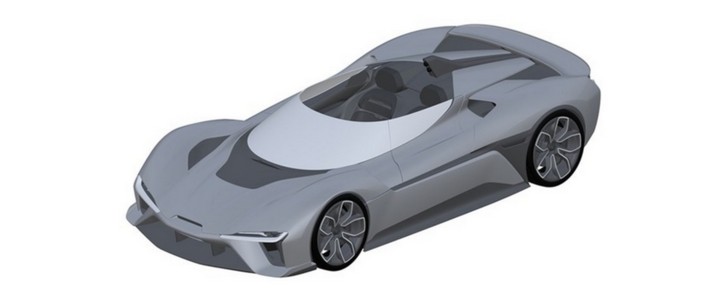We now know Nio for its luxurious EVs with swappable batteries, but it was not always like that. When the company started its career, it presented an electric hypercar called EP9. Its first batch consisted of six units, and ten more were promised to regular customers, but we never heard about them. Perhaps they were waiting for the topless version of the electric hypercar to emerge. Thanks to patent images, we know what it looks likes.
CNEVPost revealed the patent files and said no relevant information about the new vehicle was in the China National Intellectual Property Administration. All we have are the images and our guesses on why Nio registered them only now: the EP9 was presented in 2016.
EP9 stands for Electric Performance 9, and the first six cars remained in the hands of Nio investors, which paid £2.5 million each for their hypercars. Apart from William Li, Nio’s founder, the other owners are Lei Jun (founder of Xiaomi), Li Xiang (founder of Autohome and LiAuto, two relevant Chinese car news websites), Pony Ma (founder of Tencent), Liu Qiangdong (founder of JD.com), and Zhang Lei (founder and CEO of Hillhouse Capital). If Nio decides to produce the topless derivative, they should be given preference once again.
The EP9 also had a swappable battery pack and a range of 427 km. Each of its four high-performance motors helped deliver a total of 1 MW (1,341 hp) and 1,480 Nm (1,092 pound-feet). With that kind of power, the 1,735-kg (3,825-lb) hypercar could go from 0 to 100 km/h (62 mph) in 2.7 seconds and reach a top speed of 313 km/h.
Without the aid of a hardtop, the hypothetical cabrio version of the EP9 would be much slower, but such a car would probably appeal to people willing to see and to be seen. The more patiently it cruises, the more effective that mission may be.
EP9 stands for Electric Performance 9, and the first six cars remained in the hands of Nio investors, which paid £2.5 million each for their hypercars. Apart from William Li, Nio’s founder, the other owners are Lei Jun (founder of Xiaomi), Li Xiang (founder of Autohome and LiAuto, two relevant Chinese car news websites), Pony Ma (founder of Tencent), Liu Qiangdong (founder of JD.com), and Zhang Lei (founder and CEO of Hillhouse Capital). If Nio decides to produce the topless derivative, they should be given preference once again.
The EP9 also had a swappable battery pack and a range of 427 km. Each of its four high-performance motors helped deliver a total of 1 MW (1,341 hp) and 1,480 Nm (1,092 pound-feet). With that kind of power, the 1,735-kg (3,825-lb) hypercar could go from 0 to 100 km/h (62 mph) in 2.7 seconds and reach a top speed of 313 km/h.
Without the aid of a hardtop, the hypothetical cabrio version of the EP9 would be much slower, but such a car would probably appeal to people willing to see and to be seen. The more patiently it cruises, the more effective that mission may be.






